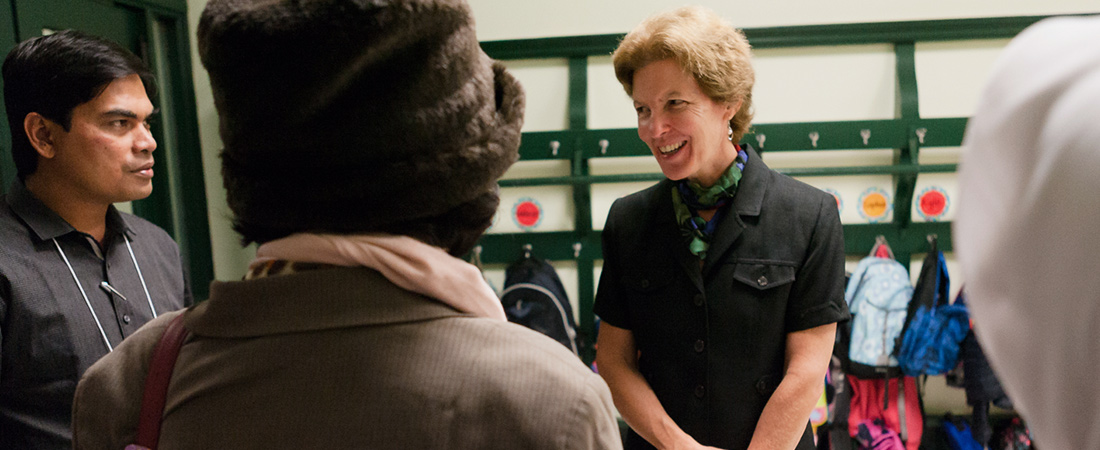An Educator at Heart

In the fall of 1984, Mary Burns began her teaching career in Kingston, Jamaica. She was fresh out of college, and her lofty task was to help 35 high schoolers learn French well enough that they could pass their A-level exams in eight months’ time.
Nobody passed. Looking back, she knows why.
“I had the art of teaching down,” she says. “I had the personality. I liked the kids—I was fun. But I didn’t have the science part down. And the science of good teaching is most important.”
Burns loved being in the classroom, though, so she stuck with teaching for a decade longer. From Jamaica, she taught in the inner-cities of Boston and Omaha, moved to the Texas-Mexico border, and ended up at a private university in Mexico City. And as she worked in the classroom, she gradually became more interested in the professional growth of her fellow teachers. These teachers were learners, too—but their desires to become better teachers were largely going unaddressed.
Burns thought of her own experiences as a first-year educator.
“We had no training. We were just thrown into these classrooms and expected to teach,” she says. Though she didn’t think about it then, it troubles her now.
“When you teach, you are given other peoples’ children. You have to handle them with care. But you can only handle them with care if you know what you are doing.”
So Burns set out to change that. Over the last 20 years, she has worked to improve teachers’ access to high-quality professional development around the world, from Russia to Namibia to Ecuador. She helped build Lebanon’s country-level education technology plan, worked with elementary school teachers in Africa and Asia, and wrote a book about best practices in online teacher training.
Teacher-centered learning
Burns led Indonesia’s first coaching program to help teachers integrate technology into teaching. The effort met significant resistance at first, because coaching was not usually part of donor-funded teacher professional development programs. But Burns persisted with her idea, and credits EDC colleagues Steve Anzalone and Michael Calvano with helping to implement it.
The results were impressive. Teachers in the coaching program thrived, and 98 percent of them implemented their learner-centered, technology-based activities in their own classrooms.
Burns says she continues to do this work because she is inspired by the teachers that she meets. She talks about Kay Chadwick, a “hard as nails” teacher from Carencro Middle School in Louisiana.
“Kay was a skeptic and a leader, and cared deeply about students,” recalls Burns. “Her bottom line was that if it truly helped students, she’d do it, and she brought the other teachers along, too. I was a coach to her, but she was an inspiration to me.”
She also talks about Paritta Prayoonyong, a university instructor in Thailand. Burns is currently working with her as part of a professional development program on project-based learning (PBL).
“I’m so inspired by Paritta because she doesn’t have to do this—she could just focus on her research,” she says. “But she saw that if she does PBL with her students, they will have a better learning experience. She’s worked so hard to give them this opportunity, and she truly cares about her students and their learning. I’m lucky to be able to work with someone like that.”
Burns believes that teacher professional development has improved considerably since she was a teacher. In the United States, more than 40 states have professional development standards on the books. And internationally, there is a much greater recognition of what makes for effective professional learning for teachers. Yet she says there is still work to do.
“Schools are getting better at recognizing the importance of student-centered learning, but we haven’t yet transferred that idea over to teacher education,” she says. “Teachers need teacher-centered professional learning. They need ‘a voice and a choice’ just like their students. But in so many places, they are still treated as cogs in the machine.”
The ultimate thank you
During her years of working with educators, Burns’ own classroom experiences were never far from her mind. So in 2014, she wrote about how teaching in Jamaica had sparked her lifelong interest in working with teachers as learners. The article gained traction on social media, and within hours, the very first students Burns had ever taught were writing back to her.
“We have reminisced often about the young American teacher we loved to tease,” wrote one former student. “For me, the simple introduction to the French language that you provided led to a lifelong love affair. Merci, beaucoup.”
It was the ultimate thank-you note.
“I was stunned and excited and really moved,” says Burns. “They wrote that they fell in love with French because of me—but I fell in love with teaching because of them.”
